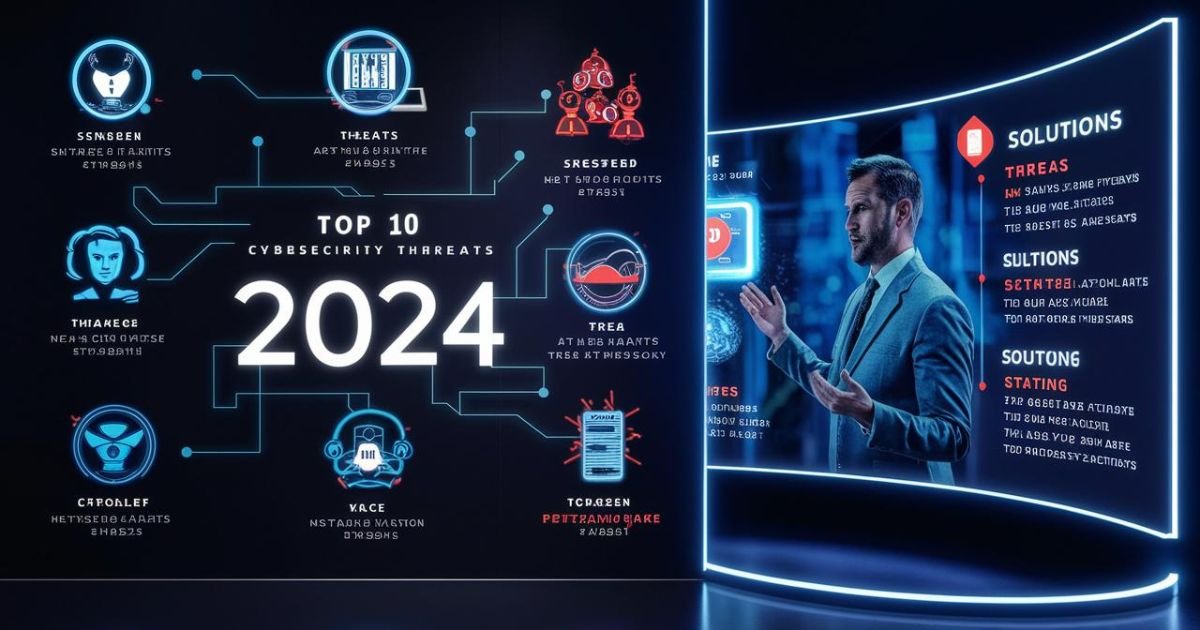In 2024, the digital landscape continues to evolve at a rapid pace, and so do the cybersecurity threats that businesses and individuals face. With the increasing integration of technology into every aspect of our lives, the need for robust cybersecurity measures has never been more critical. In this article, we’ll explore the top 10 cybersecurity threats of 2024 and provide actionable strategies to help you avoid them.
1. Ransomware Attacks
Ransomware will remain one of the most significant cybersecurity threats in 2024. Attackers encrypt a victim’s data and demand a ransom in exchange for the decryption key. These attacks can cripple businesses and lead to substantial financial losses.
How to Avoid It:
- Regularly back up your data and store it offline.
- Implement strong email filtering systems to block phishing emails.
- Use advanced endpoint protection software that detects and blocks ransomware.
2. Phishing Scams
Phishing continues to be a pervasive threat, with attackers using deceptive emails and messages to trick individuals into revealing sensitive information such as passwords and credit card numbers.
How to Avoid It:
- Educate employees about the dangers of phishing and how to recognize suspicious emails.
- Use multi-factor authentication (MFA) to add an extra layer of security.
- Implement email security solutions that identify and block phishing attempts.
3. Supply Chain Attacks
Supply chain attacks occur when hackers target a less secure part of a supply chain in order to compromise the security of a larger organization. These attacks have become increasingly sophisticated and will be a major concern for businesses in 2024.
How to Avoid It:
- Conduct thorough security assessments of all third-party vendors and suppliers.
- Implement strict access controls and regularly monitor network activity.
- Use encryption to protect sensitive data shared with third parties.
4. AI-Powered Cyber Attacks
Cybercriminals are weaponizing artificial intelligence (AI) to launch more advanced and targeted attacks. AI can automate the process of finding vulnerabilities and executing attacks at scale.
How to Avoid It:
- Invest in AI-driven cybersecurity tools that can detect and respond to threats in real-time.
- Regularly update software and systems to patch known vulnerabilities.
- Monitor network traffic for unusual patterns that may indicate AI-driven attacks.
5. IoT Vulnerabilities
The Internet of Things (IoT) continues to expand, connecting everything from smart home devices to industrial machinery. However, many IoT devices lack robust security features, making them prime targets for cybercriminals.
How to Avoid It:
- Change the default passwords on all IoT devices.
- It is important to segment IoT devices on a separate network from critical systems.
- Regularly update the firmware and software on all IoT devices to fix security vulnerabilities.
6. Zero-Day Exploits
Attackers can exploit zero-day exploits, vulnerabilities unknown to the software vendor, before a patch becomes available. These threats are particularly dangerous because they offer no warning before an attack occurs.
How to Avoid It:
- Employ intrusion detection systems (IDS) that can detect and block suspicious activities.
- Engage in bug bounty programs to promote the identification of vulnerabilities before they become exploitable.
- Keep all software and systems up-to-date with the latest security patches.
7. Insider threats
Insider threats involve employees or contractors who misuse their access to an organization’s systems to steal data or cause damage. These threats can be difficult to detect because they come from within the organization.
How to Avoid It:
- Implement strict access controls and only provide employees with the minimum access necessary for their job roles.
- Monitor user activity for signs of unusual behavior.
- Conduct regular security training to raise awareness about the risks of insider threats.
8. Cryptojacking
Cryptojacking is the unauthorized use of someone’s computer to mine cryptocurrency. This type of attack can slow down systems, increase electricity costs, and cause hardware damage.
How to Avoid It:
- Use ad-blockers and anti-cryptojacking browser extensions to prevent malicious scripts from running.
- Monitor your system’s performance for signs of cryptojacking, such as unusually high CPU usage.
- Implement endpoint security solutions that can detect and block cryptojacking malware.
9. Social Engineering Attacks
Social engineering involves manipulating individuals into divulging confidential information or performing actions that compromise security. This could be through phone calls, emails, or even in-person interactions.
How to Avoid It:
- Educate employees about the tactics used in social engineering attacks.
- Implement strict verification processes before sharing sensitive information.
- Use security software that can detect and block social engineering attempts.
10. Cloud Security Breaches
As more businesses move their operations to the cloud, cloud security breaches have become a significant concern. Misconfigurations, weak access controls, and vulnerabilities in cloud services can lead to data breaches.
How to Avoid It:
- Implement strong access controls and encrypt data stored in the cloud.
- Regularly audit your cloud configurations to ensure they follow security best practices.
- Use cloud security solutions that provide real-time threat detection and response.
Conclusion
As technology continues to advance, so do the cybersecurity threats that we face. By staying informed about the latest threats and implementing robust security measures, you can protect your data and systems from the most dangerous attacks in 2024. Remember, cybersecurity is not a one-time effort but an ongoing process that requires constant vigilance and adaptation to new challenges.
By optimizing your cybersecurity practices and staying ahead of emerging threats, you can minimize risks and safeguard your digital assets in an increasingly connected world.
